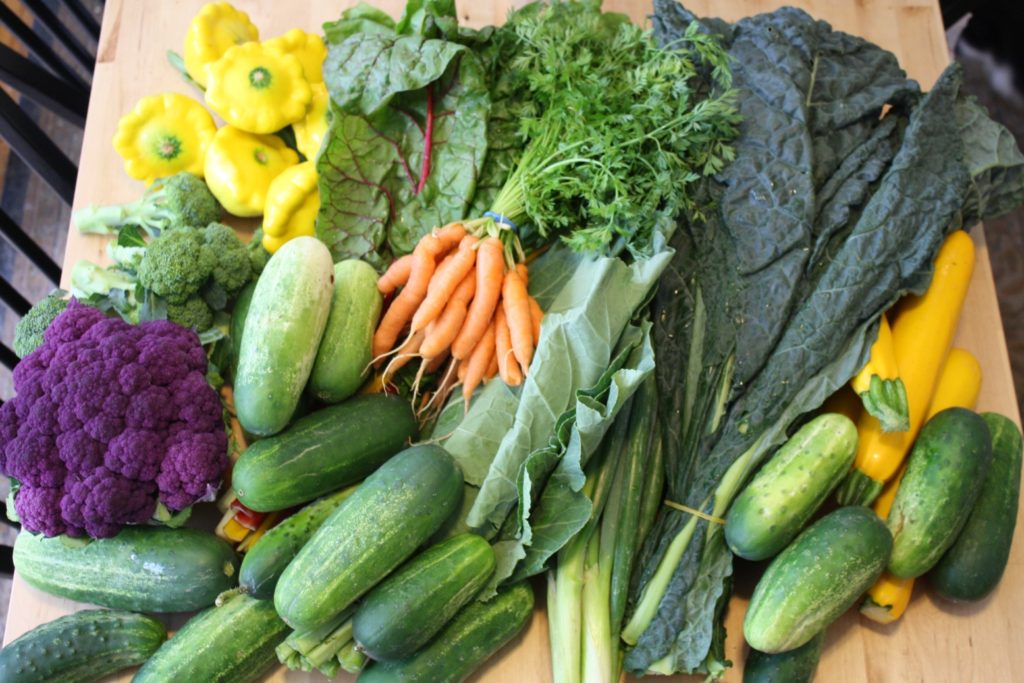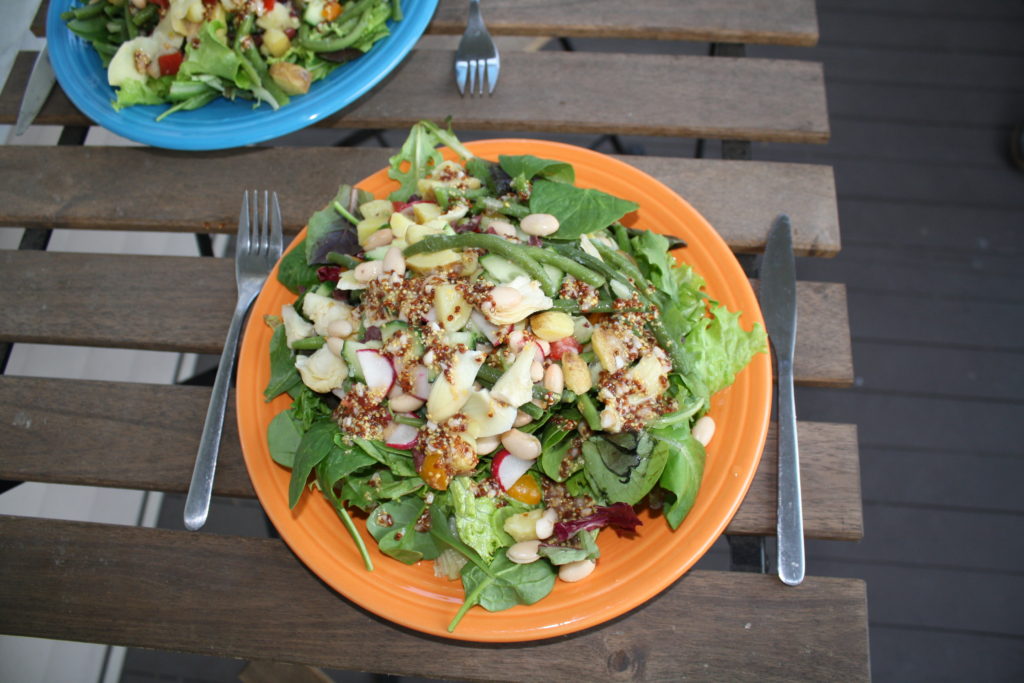
Farmers markets make plant-based eating even more affordable. This is what $21 worth of food looks like from our farmers market.
A whole-food, plant-based diet is already the cheapest way to eat. During farmers market season, it’s even cheaper.
Our introduction to the whole-food, plant-based lifestyle came from an unlikely source. Some years ago we became more serious about saving money, so we started participating in online finance forums. We found that quite a few of the most frugal members ate a plant-based diet. At first they started with a plant-based lifestyle because it saved them so much money, but in the end they kept it up because it made them feel so good and energetic.
A quick look at the numbers
Of course this was old news for those who had been plant-based before us. John McDougall has been plant-based for 40 years and specifically addressed the money-saving benefits of the lifestyle in his classic best-seller, The Starch Solution. He also put together a striking comparison between the costs of conventional diets versus plant-based eating, where he explained that you can enjoy a plant-based diet on just $3 per day. Following up more recently on his comparison, Rosane Oliveira wrote an article entitled “Cheap or Expensive? The REAL Truth About Plant-Based Diets.” She showed that the cost of an omnivorous meal is roughly three times higher than that of a similar plant-based alternative. Michael Greger, author of How Not to Die, has also addressed the topic on numerous occasions, both in his book (briefly) and in videos posted on his website. In these three videos he specifically talks about how the cheapest foods can represent the best long-term investment.

This haul cost only $14. It’s amazing to think that you can eat so many delicious plant-based foods at such low prices.
Farmers markets make cheap food even cheaper
Simply having access to fresh, delicious fruits, vegetables and other plant-based foods is fantastic on its own. Thanks to farmers markets, they are also at their lowest prices of the year right now. It’s the middle of summer, we are enjoying the life-giving bounty of the best the earth has to offer, and yet somehow we are spending the least amount of money on food that we will spend all year. Cucumbers are 50 cents per pound, bell peppers are 63 cents each or even less, potatoes can be cheaper than 25 cents per pound, collard greens cost six times less than grocery stores or coops (see below), beets with their greens average less than $1 per pound, and so on.
We are fortunate to live near what I believe is the most reasonably priced farmers market in all of Minneapolis. The Midtown Farmers Market is active throughout the season, but this is the time of year when prices start to drop the most, since yields and competition keep increasing from now until the end of October. Competition is best on the main market day, however, so if your market meets more than once per week, be sure to go on the primary market day. For us that’s Saturday. It also meets on Tuesday, but there tend to be far fewer vendors and customers. Because of this, they don’t always discount their food as much as when the market is full. There is little incentive to offer discounts when both merchants and buyers are scarce.

Be sure to look out for exotic produce at your local farmers market. Purple cauliflower is a lot like regular cauliflower but with an earthy taste.
Farmers markets let you buy more “exotic” foods
Although kohlrabi is not really exotic at all, it is prohibitively expensive in grocery stores near us. Buying it at the farmers market, however, makes it affordable, since it costs about five times less. Other farmers market foods like heirloom carrots, purple cauliflower and purple potatoes are generally priced about the same as their traditional counterparts, so rather than spending more for the exotic color of purple potatoes, for example, you simply pay the traditional potato price. In grocery stores this is rarely the case, so you’ll find yourself paying a premium for the added color.
While they are also not exotic per se, hearty greens are so inexpensive during farmers market season that we eat them nearly every day. Kale, Swiss chard and collard greens cost $1 per bunch at our farmers market, compared to up to $3.50 per bunch in a grocery store or co-op. Not only are the grocery store bunches more than three times as expensive, they are also usually about half the size. Collard greens are currently my favorite vegetable, and I love being able to eat them more often during farmers market season.
Try a different farmers market if yours is overpriced or low in quality
It’s true that some farmers markets in the Minneapolis metro area are significantly more expensive and also offer produce whose freshness and quality seem pretty dubious. If your farmers market doesn’t offer low enough prices or fresh enough produce, try a different one. The main farmers market in downtown Minneapolis is the biggest and is generally as cheap and as fresh as Midtown.
Also, don’t be afraid to touch and even pick up the produce to get an idea of its quality and freshness. I do this all the time, and while I occasionally get confused looks from sellers, they are never rude about it. If I am spending money on something, I am definitely going to guarantee its quality first. If there is a stack of kale on the table, there is no reason not to go through all of it to find a bunch with the fewest blemishes. I find it’s especially important to double check cucumbers and bell peppers as the season goes on, since they easily develop soft spots. I’m always bewildered by buyers who simply ask for produce by name and don’t personally inspect what is clearly laid out before them.
Seize the kale!
Saving money year-round is a nice bonus to the plant-based lifestyle in general, but the biggest opportunity is happening right now during farmers market season. Don’t miss out!
What are your favorite ways to save money on plant-based foods? Let us know in the comments!




